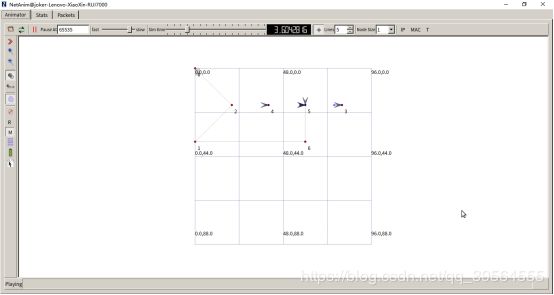计算机网络原理 实验1《NS3路由模拟实验》
实验1《NS3路由模拟实验》
一、实验目的
- 了解NS3网络模拟器的基本操作;
- 学习采用距离矢量算法(Distance Vector Algorithm)的动态路由。
二、实验内容
本实验的主要实验过程分别是:搭建NS3平台的坏境和学习采用距离矢量算法(Distance Vector Algorithm)的动态路由。此外,在实验过程中需要同学们自学linux操作系统的安装和使用(可在虚拟机中安装linux,本实验指导书使用的VMware虚拟机中的ubuntu操作系统),熟悉linux下的软件开发过程(如vi编辑器,gcc编译器),熟悉C++、Python编程语言。
三、实验方法
利用Vmware 14 + CentOS 7.6 开发工具进行NS3路由模拟实验。
四、实验步骤
- 安装NS3(参考官方教程:https://www.nsnam.org/wiki/Installation)
(1)开发环境配置:
在CentOS系统中按照如下命令进行操作:
yum install gcc-c++ python //运行环境要求
yum -y install python-devel //Python开发头是启用Python绑定所必需的(用于从Python编写ns-3程序)
yum install qt5-devel //netanim动画器需要Qt5开发包
yum -y install mercurial //Mercurial需要与ns-3开发存储库一起工作
yum install doxygen graphviz ImageMagick //Doxygen和相关的内联文档
yum install python-sphinx dia texlive texlive-latex //ns-3手册和教程是用reStructuredText为Sphinx编写的(doc/tutorial、doc/manual、doc/models),通常用dia编写图形
yum install openmpi openmpi-devel //基于mpi的并行分布式仿真支持需要openmpi
yum install tcpdump wireshark //读取ns-3生成的pcap数据包跟踪
yum install sqlite sqlite-devel //对统计数据的数据库支持
yum install libxml2 libxml2-devel //配置存储的基于xml的版本(需要libxml2 >= 2.7版本)
yum install uncrustify //支持utils/check-style.py风格的检查程序
yum install boost-devel //对openflowswitch的支持需要一些Boost库
// 支持ns-3-pyviz可视化器
yum install graphviz graphviz-devel python-setuptools-devel ipython
sudo easy_install pygraphviz
yum install goocanvas pygtk2-devel
yum install git //需要Git来获取click模块路由和pygccxml
yum install gsl gsl-devel //一个可选但推荐的包(用于提高一些无线模型的保真度)是GNU科学库
yum install gtk2 gtk2-devel //一个基于gtk的配置系统
yum install gdb valgrind //调试
  (2)使用Mercurial下载ns-3
cd 自定义安装目录
mkdir repos
cd repos
hg clone http://code.nsnam.org/ns-3-allinone
![]()
cd ns-3-allinone-3.29/
./download.py
(3)编译NS3以及图形化界面程序NetAnim
cd ns-3-allinone-3.29/
./build.py
cd ns-3-allinone-3.29/ns-3-dev
./waf -c auto
cd ..
cd netanim-3.108
make clean
qmake NetAnim.pro
make
(5)运行仿真界面
cd netanim-3.108/ //进入图形界面目录
./NetAnim //运行图形界面,即可看到如下界面

2.编写动态路由算法实现路由模拟程序
根据距离矢量算法实现模拟程序编码工作,具体源码如下所示:
//ns3routing.cc
#include - 测试验证NS3静态路由
实验结果见第五点。
五、实验结果
在CentOS 中按照以下命令操作,即可运行图形界面并进行程序操作。
cd netanim-3.108/ //进入到netanim目录下
./NetAnim
六、实验小结
本次实验主要是了解NS3网络模拟器的搭建与使用,在CentOS平台搭建过程中还是遇到了很多问题,主要是由于官方教程版本很久未更新了,导致部分软件版本对不上甚至不存在,另一个问题实验程序的编写与使用,主要是参考过往资料进行解读与重新编写使用。
参考文章:【1】基于Centos7的NS-3安装总结(超详细!超完整!)
【2】NS3入门与安装
【3】Installation - Nsnam
【4】NS3 安装可视化动画工具netanim
【5】Centos7系统安装Qt5.9
【6】CentOS 7做流程图软件






















